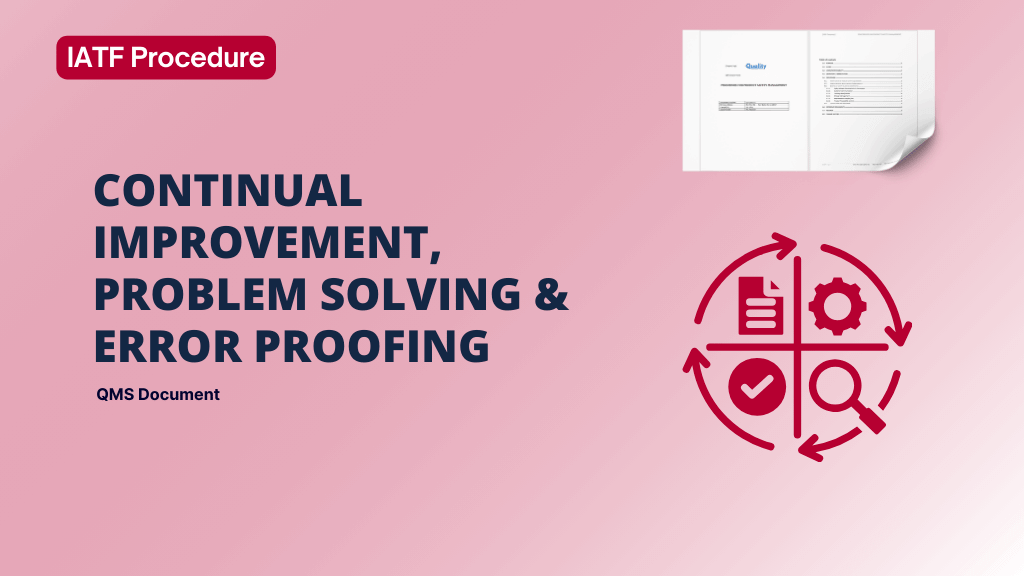Continual improvement is a primary objective of any organization. Every employee should adapt an improvement approach to grow personal as well as organization vision.
This article covers every aspect of improvement and you can learn how to get into this approach and make a good career move.
Every interview you may ask to showcase how you have done the improvement in your company or how you have been involved in the continual improvement journey.
Then you should know the complete process of improvement along with you can link to your current position and what’s working in your organization.
Let’s dive into this,

What is Improvement in organization? #
Every organization has the processes and system to create the product, which has abnormalities which leads to create the defective product, decrease productivity and other wastes in organization.
To solve those issues we do the analysis, find out causes take appropriate actions and correct those situation, therefore this all process we called as improvement.
What is continual improvement? #
Continual improvement is the ongoing process of doing the improvements. Where we do plan the activity, do all necessary action steps, check the effectiveness, standardize and act accordingly in future with improve steps.
There are many methods such as PDCA cycle, Kaizen are helps for continuous improvement in the organization.
Procedure of Continual Improvement / Problem Solving / Error Proofing #
1. PURPOSE #
To establish a documented procedure to define the continual improvement, problem solving & error proofing and related responsibilities and authorities for dealing with it.
2. SCOPE #
Applicable all processes, product & QMS
3. RESPONSIBILITY #
Top management, Process Owners & QMS Coordinator.
4. DEFINITION / ABBREVIATION #
NIL
5. PROCEDURE #
The continual improvement/ problem solving / error proofing is recurring activities to increase the ability to fulfill the requirements. The process of establishing objectives and finding opportunities for improvements is a continual process through use of quality objectives, customer satisfaction levels, audit finding, analysis of data, Risk analysis, management reviews or other means
The continual improvement/problem solving/error proofing is project-based activities.
Top management are identify the continual improvement/problem solving/error proofing projects. They refer many sources/opportunities to identify the projects. Such as, Quality objectives, customer satsfaction levels, audit finding, analysis of data, management reviews, benchmarking or any other means as appropriate.
The projects identified are in line with quality policy or quality objectives or strategic plans, risk analysis.
The continual improvement/problem solving/error proofing projects are at company level or at functional/department levels.
Project selection #
The top management identifies Team leader, Team members within a department or MDT, target period, background (reason for project) and objective (what is to achieved) of CONTINUAL IMPROVEMENT/PROBLEM SOLVING/ERROR PROOFING PROJECTS at company level.
The leader identified indicates above details in team charter form. The identified project is registered by giving project number.
The departmental head can identify team leader, team members within a department or MDT, target period, background (reason for project) and objective (what is to achieved) of CONTINUAL IMPROVEMENT/PROBLEM SOLVING/ERROR PROOFING PROJECTS at departmental level.
The HOD may consult Top Management if required.
The leader identified indicates above details in prescribed form.
The continual improvement/problem solving/error proofing Projects may be classified as per objective, for ex. Cost reduction, Quality improvement, Productivity improvement, Line balancing, delivery, safety, reduction in cost of poor quality, competence enhancement etc.
Working on projects #
The CONTINUAL IMPROVEMENT/PROBLEM SOLVING/ERROR PROOFING PROJECTS is worked out with various steps such as
- Collection of relevant data
- Analysis of data
- Justification of problem selection
- Root cause (s)
- Identifying and selecting solutions, methodology used
- Decide action plan for implementation
- Implement and monitor action plans
- Review / verify the results with respect to Objective.
- Control & Standardization
While working on projects following appropriate statistical techniques are used
The employee involvement/participation may be achieved through working in MDT
While working on the project the team meets regularly to review the progress and assign the work among them and record the action plan
The Leader and team may seek guidance & required resources from HOD / Top Management
Data and analysis is indicated in CONTINUAL IMPROVEMENT/PROBLEM SOLVING/ERROR PROOFING PROJECTS form.
The initial data/level of performance and after completion of project is compared on same scale and indicated in form.
Objectives are then compare with project result, once after completion of action plan. If the project results are not satisfactory then the cycle of improvement must repeate and continue.
The leader indicates conclusion of the CONTINUAL IMPROVEMENT/PROBLEM SOLVING/ERROR PROOFING PROJECTS completed, recommendations for future actions and benefits observed out of this.
Evaluation of project #
The relevant evaluation criteria is decided and indicated in evaluation part of format. The evaluation criteria example are (similar to classification)
- Cost reduction/saving
- Reduction in cycle time
- Productivity improvements etc.
HOD and QMS Coordinator evaluate the projects with respect to criteria and score evaluation. Then they will approve with signature.
Plant Head may evaluate the project and seek for signature.
Continual Improvement of the Organization
Above procedure including suggestion scheme/kaizen etc. are the improvement processes of organization and it has been clearly define.
Manufacturing Process Improvements
Improvement of process capability for CTQ product characteristics.
Reduction in variation of all input/output characteristics of the process
6.0 REFERENCE DOCUMENTS #
- IATF 16949:2016 Standard
- ISO 9001:2015
- Problem Solving Procedure
7.0 RECORDS: #
| F-SYS-XX | KAIZEN SHEET | 01-02-2018 |
| F-SYS-XX | TEAM CHARTER FORM | 01-02-2018 |
| F-SYS-XX | 8D REPORT | 01-02-2018 |
| F-SYS-XX | LESSON LEARNT SHEET | 01-02-2018 |
8.0 CHANGE HISTORY #
| Rev. No. | Rev. Date | Description | Prepared By | Approved by |
| 01 | 01.08.2017 | Continual Improvement, Problem Solving & Error Proofing | Mr. John | Mr. Michael |
Download free Procedure of CONTINUAL IMPROVEMENT, PROBLEM SOLVING & ERROR PROOFING #
You can use this template and make it as per your organization by just updating some content, logo & Company name.





